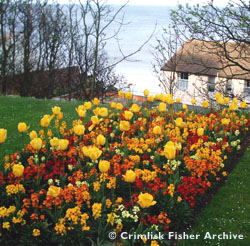 |
||||||||||||||||||||||||||||||||||||||||||||||||||||||||||||||||
|
||||||||||||||||||||||||||||||||||||||||||||||||||||||||||||||||
| ||||||||||||||||||||||||||||||||||||||||||||||||||||||||||||||||
Exploring Filey's Past - Supported by Filey Town Council  In 1823 the "Directory of the North and East Ridings" gave the brief description of Filey below. In 1823 the "Directory of the North and East Ridings" gave the brief description of Filey below.FILEY, (P.) in the waps. of Pickering Lythe, and Dickering; 7½ miles SE. of Scarborough, situated on the banks of a noble bay, abounding with excellent fish, and famous for its lobsters; the sands are very firm, and are bounded on the north by a remarkable ridge of rocks, extending nearly half a mile into the sea, called Filey Bridge. The parochial chapel, which is dedicated to St. Bartholomew, is in the patronage of the Osbaldeston family; here is likewise a Methodist chapel. A very fine spring adjoins the church yard, and supplies the place with most excellent water. Population 773. Two centuries ago all the population were involved in fishing in some way with the men going to sea while the women baited the lines, others built the boats as one retired fisherman said to me "Filey was built on fishing." Today fishing means salmon, crabs and lobsters but no fish are caught and the towns population has grown to around 7,000 with only a handful of these involved in the towns traditional occupation. In the mid-1840's the railway arrived and making it easier to visit brought a great influx of wealthy summer visitors changing the town considerably so that Kelly's Directory in 1872 described the town as; FILEY is a township, parish, station on the North Eastern .Railway, fashionable watering-place, market, and fishing town, 7½ miles south-east from Scarborough, 12 north-north-west from Bridlington by road and 13½ by rail, 2½ north-east from Hunmanby, 44¼ north by rail from Hull, and 215 north from London, situated on the eastern coast, partly in the wapentake of Dickering, and partly in Pickering Lythe (North Riding), Scarborough union, Dickering petty sessional division and county court district, Scarborough rural deanery, archdeaconry of the East Riding, and diocese of York. Filey has risen since 1831 from a mere fishing village to an important watering-place, and from the rapid and spirited improvements going on bids fair to rank amongst the higher bathing places: it is delightfully situated at the north-eastern extremity of the East Riding, on the shore of the bay to which it gives name; this Bay, which is open to the east, is protected from the north-easterly winds by a long ridge of rocks, extending nearly half a mile into the sea, and anciently called the File, but now Filey Brigg, which, projecting from a narrow tongue of land, forms a sort of natural pier or breakwater resembling the celebrated Mole of Tangiers. Here sloping rocks are covered with boulders of prodigious size, numbers of them weighing from forty to fifty tons; scaur after scaur, in perpendicular form, rise to a height of 20 feet; and most curious caverns in the rocks, like Roman amphitheatres, are seen, which have been hollowed out by the action of the waves : about midway of this wonderful brigg, where it, is the highest, and at an angle of about 45 degrees there juts out from its south side another ridge of rocks called "Spittals," which are only visible at low water and during spring tides, this extensive ridge of low rocks may at ebb tide be reached to its eastern extremity, whence a beautiful view of Scarborough Cliffs and Castle, and the noble promontory of Flamborough, can be obtained at high water it is overflowed, and with the wind from the north-east the heavy waves break over it, throwing broad sheets of spray high into the air. The bay is protected on the south by Flamborough Head, and thus affords a safe shelter for ships of any burthen, and is admirably adapted by nature for a harbour of refuge, available for ships of any size, and was strongly recommended by the Commissioners for Harbours of Refuge as the most suitable place on the coast. Here was the "Portus Felix " of the Romans, and remains of their harbour still exist on the top of the cliff overlooking this: there were discovered some years ago, the foundations of a lighthouse or watch tower (Pharos), and other buildings, with many evidences of the presence of Roman soldiers. Its beach forms a large segment of a circle, and is sandy, firm, and smooth, and particularly well adapted for bathing; it is surrounded by high perpendicular cliff's. The cliffs to the northward of the town are generally destitute of vegetation, and are mostly of a conical form, to the southward they gradually decline in altitude until they unite with those at Speeton. The town is in two parts, called Old and New Filey; the former has long been noted as a fishing station, in which trade a great many men and boys are engaged. Herring curing is also extensively carried on here. New Filey has been built within the last thirty years, and is the chief resort of visitors: it contains many first-class lodging houses, extending along the top of the cliff to the south, commanding a beautiful sea prospect, the front being beautifully laid out in pleasure grounds, forming a pleasant promenade for visitors. The ravine which divides the North from the East Riding, was purchased by the local board; a carriage road has been formed, leading from the Scarborough-road to the beach, giving easy access to the sands; the slopes have been laid out as promenading pleasure grounds forming beautiful terraces, surrounded by trees and shrubs, a handsome iron bridge has been erected crossing to the old church. The access to the town from the railway station has been greatly improved by avenues of trees which have been planted.
|
||
site by Insight Design Solutions |
||
